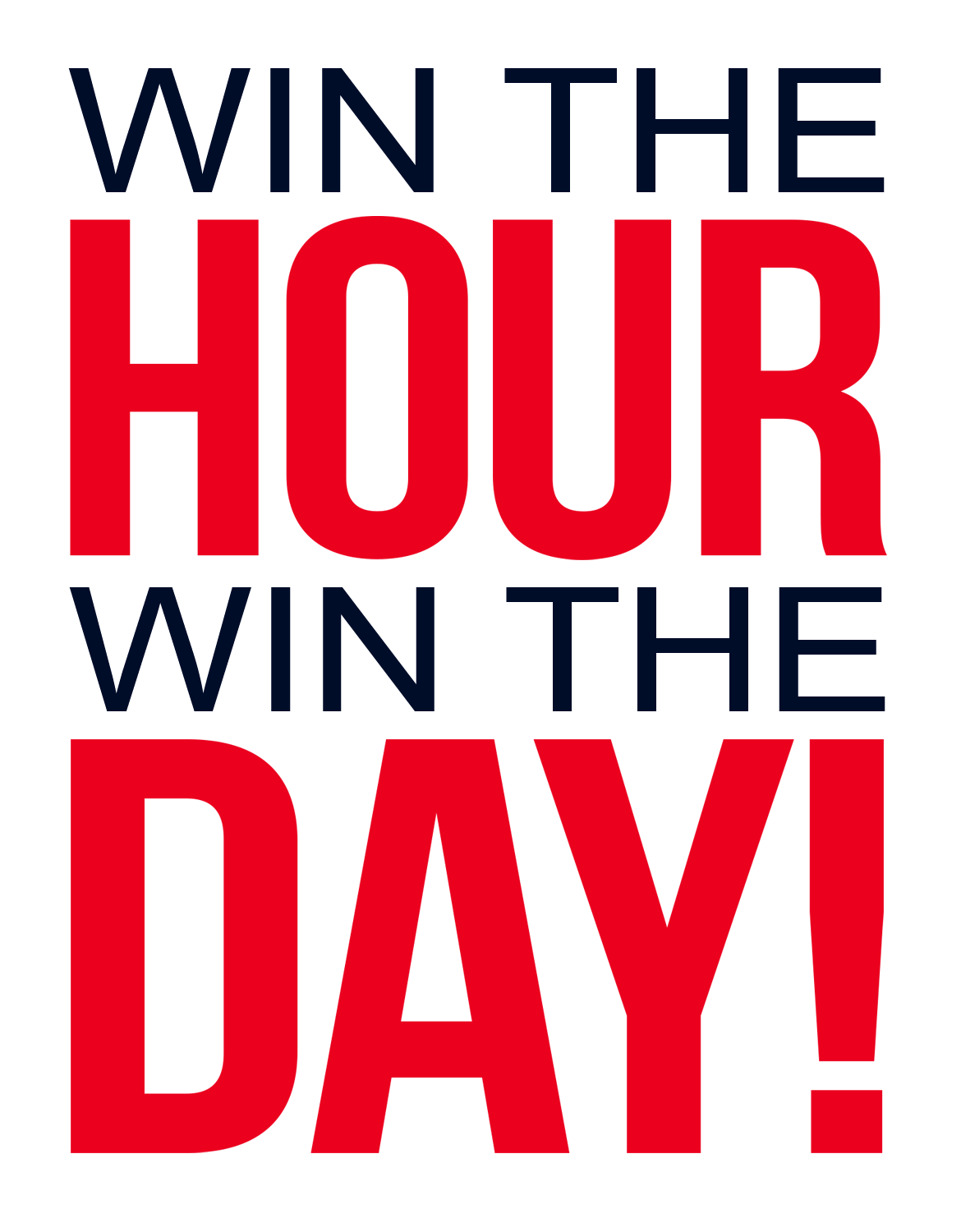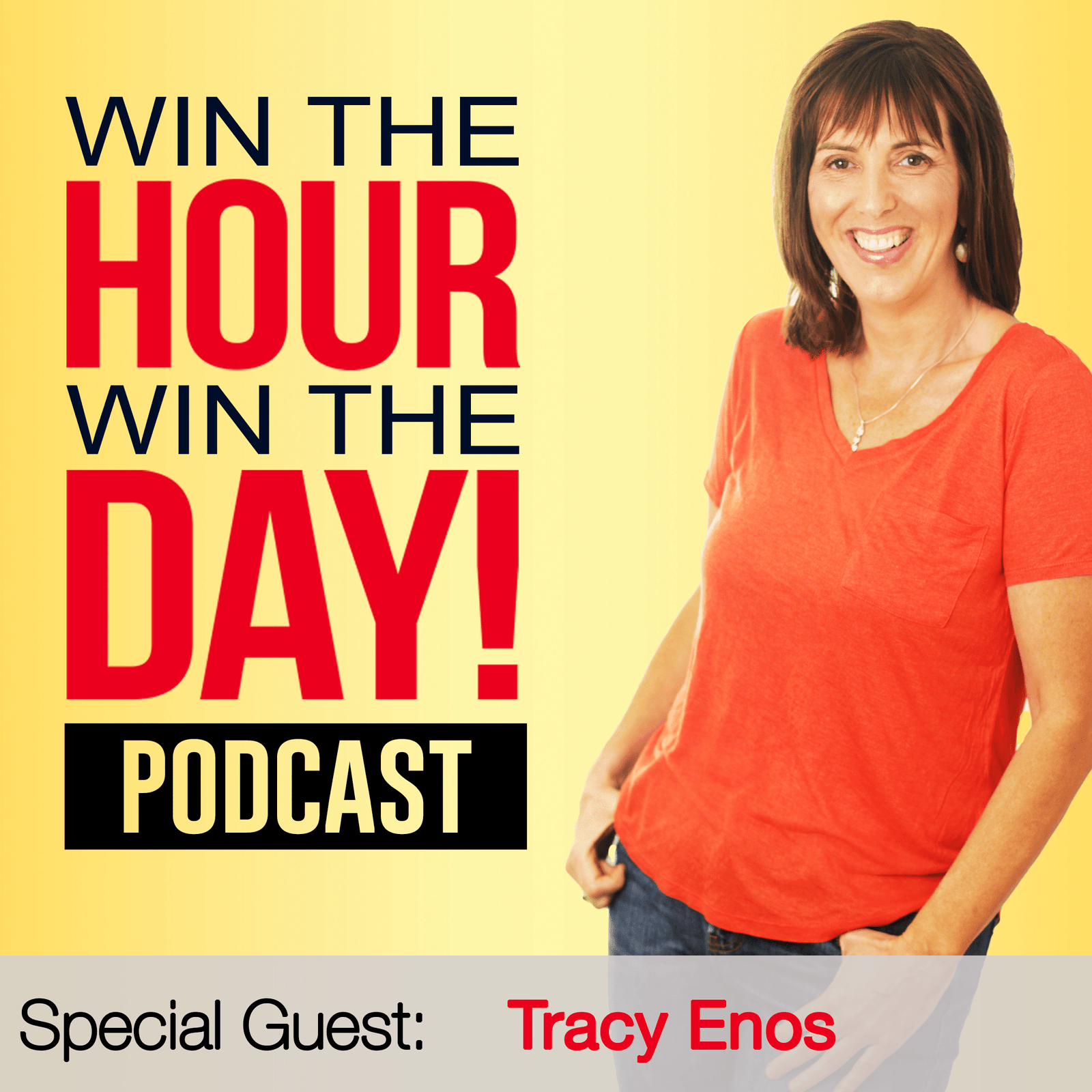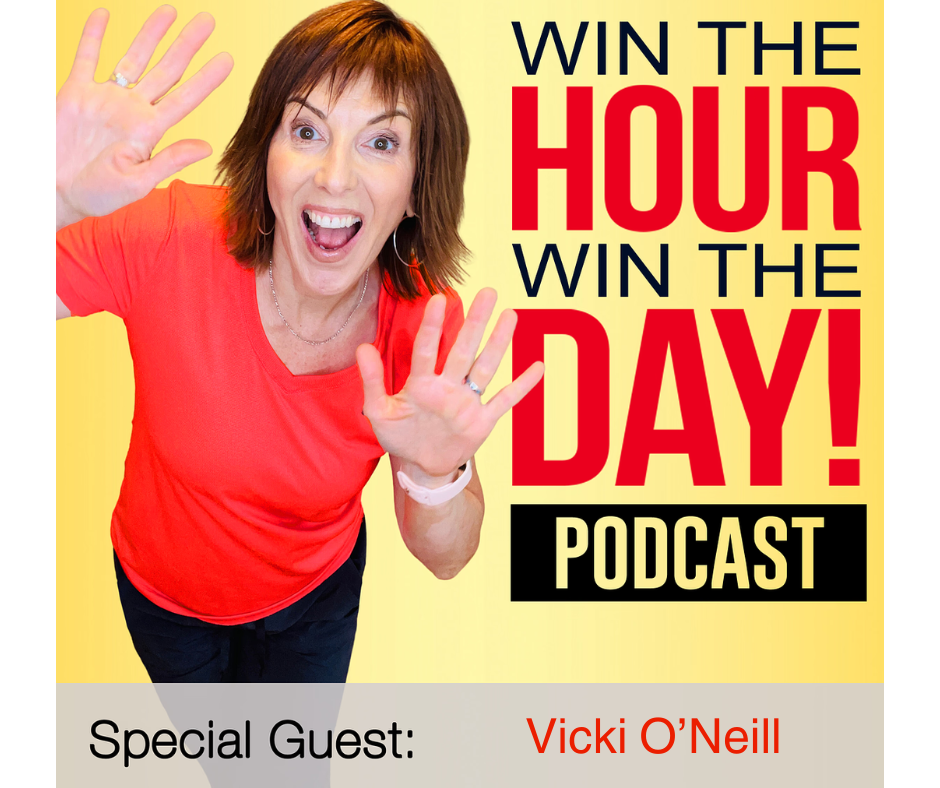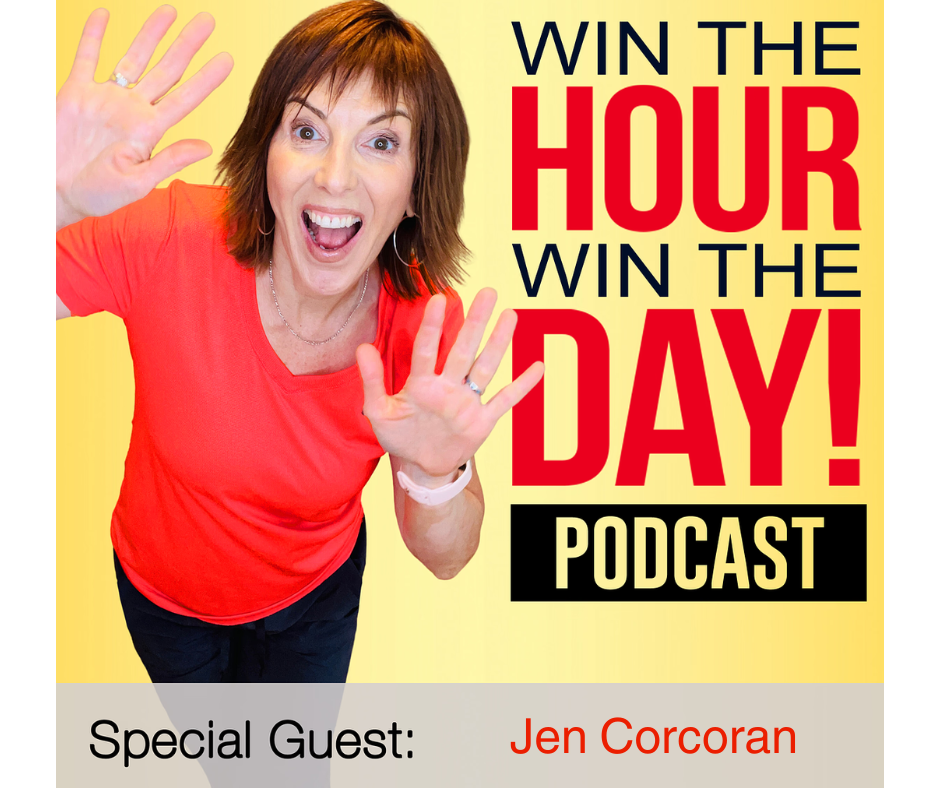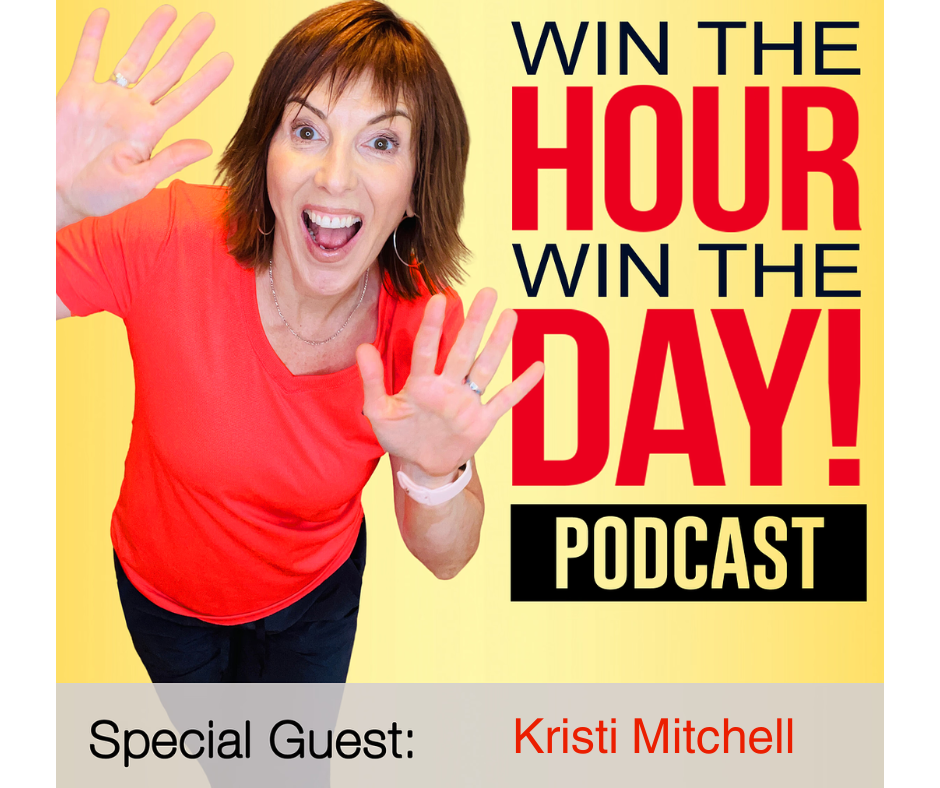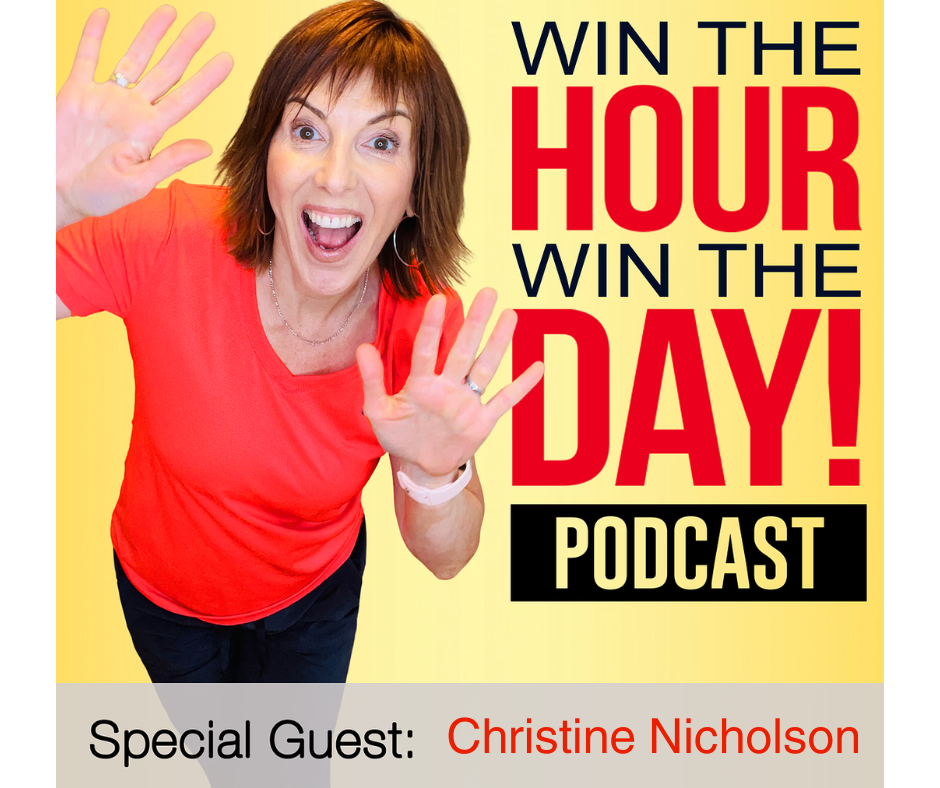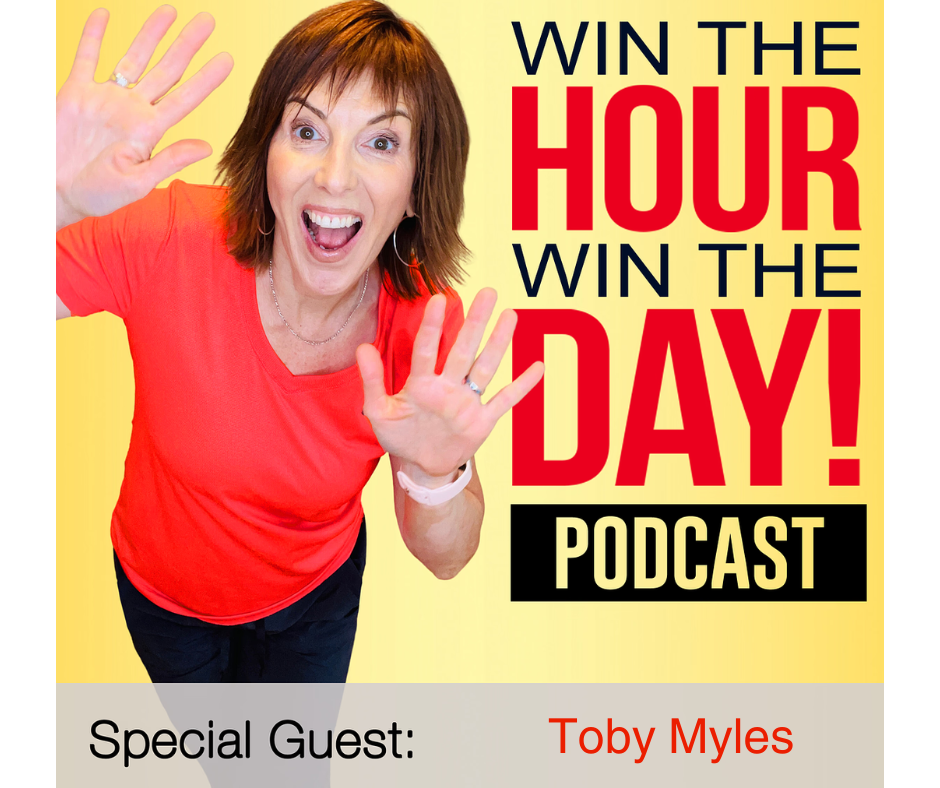Episode Summary
Tracy Enos talks Linkedin! She gives us simple but powerful techniques so we can make real connections on Linkedin!
Learn
– the big no-no’s on Linkedin and it’s not what you think!
– how to make real connections with a simple conversation!
– why it’s important to tap into some of Linkedin’s underused features
– why you want to move your connections off Linkedin
– the secret tips Tracy uses daily
Join The Community: https://www.facebook.com/groups/WinTheHourWinTheDay/
Win The Hour, Win The Day! www.winthehourwintheday.com
Podcast: Win The Hour, Win The Day Podcast
Facebook: https://www.facebook.com/winthehourwintheday/
LinkedIn: https://www.linkedin.com/company/win-the-hour-win-the-day-podcast
You can find Tracy Enos at:
Website: tracyenos.com
Facebook: https://www.facebook.com/tracyenos
Email: localhoopla@gmail.com
LinkedIn: linkedin.com/in/tracyenos
Win The Hour Win The Day
https://winthehourwintheday.com
Check out the Outsourcing Playbook For Busy Entrepreneurs here: https://winthehourwintheday.com/outsourcing-playbook
Tracy Enos Transcription
[00:13:47]Kris Ward: Hey, everyone. Welcome to another episode of Win the hour and Win the day, and I am your host, Kris Ward. And today we have Tracy Enos in the house and she’s going to get us excited about LinkedIn. No pressure, Tracy, but she is going to get us excited about LinkedIn. Welcome to the show, Tracy.
[00:14:06]Tracy Enos: Thanks, Kris. I’m excited to be here today.
[00:14:09]Kris Ward: Okay. So Tracy, we know. So, uh, that there’s been, well, I say, we know you enlightened me when we first started chatting that there’s been this big influx as far as activity goes on LinkedIn. And so it’s becoming more robust and there’s more, I guess, opportunity for engagement.
[00:14:27] So why don’t we start there? Um, you know, you reported to me, well, I’ll let you tell the report, what go ahead. So I, you sound intelligent said to me, what do I know? I’m just repeating what you said, right?
[00:14:38]Tracy Enos: Um, and actually sometimes you can repeat it better than I can. So, so, uh, no, actually LinkedIn, uh, came out with us the statistic last may that stated that their activity over the first 60 days of the pandemic, the lockdown part of the pandemic, their activity in LinkedIn increased by 55% over all of 2019. [00:15:00] Oh, okay. Okay. Tells me is that, you know, a lot of companies who were doing traditional, let’s say, you know, sales face to face or.
[00:15:10] Cold calling or they’re very local are now having to figure out ways to keep the doors open. Right. Sales coming in. And so that I believe is part of the flux in engagement with LinkedIn, they increased influx and engagement now for entrepreneurs. What did that mean for entrepreneurs or for those of, for those of you who are probably maybe having a difficult time getting in front of those people because they were not available because they’re not.
[00:15:39] They’re not active and they’re not in LinkedIn and they’re not online. This was a great opportunity for them now to start reaching people that they probably didn’t have access to in the past.
[00:15:49]Kris Ward: Okay. That’s profound. All right. So that first quarter it went up significantly. All right. So let’s just address the elephant in the room, by the way.
[00:15:58] I didn’t know where that saying came from. When was there actually ever an elephant in the room, but we’ll, we’ll Google that later. So anyhow. So, what I would say is, you know, ha I feel like, uh, I, some sort of junkie I’m I really like LinkedIn. And I think, I think I’ve done a decent job on my profile page.
[00:16:17] I know when we have LinkedIn specialists on, they’ll talk about, you know, forward facing and all this mistakes you can make, it’s not a resume. So we’ve talked about that in the show, and I think I do a fairly decent job of that. You know, at least better than most, not as good as some. So then, but what happens is I still struggle with engagement on LinkedIn.
[00:16:35] If I do something on Facebook, it’s a higher engagement. And then I think, okay, well maybe that’s just because I’m resorting back to that. It’s easier. It’s quicker. And I’m used to going back there. I’ve built maybe more of a community than on LinkedIn. And I know LinkedIn is a bad rap for communication.
[00:16:50] As far as somebody in your email inbox, there was that whole spammy. Hi, how are you want to buy from me? So I think that’s starting to slow down now, but I still struggle with even myself how to engage somebody through messaging. You know, I just, I don’t get it. It just doesn’t go well. Like it either comes off.
[00:17:12] Too shallow, like I’m saying, you know, I don’t want to go from, I would never say this, but Hey, how are you? Or I checked your, your profile kind of cool, whatever, you know, to the, the other extreme, which is salesy. So where’s the sweet spot as far as LinkedIn inbox goes?
[00:17:27] Tracy Enos: I think, um, think, think back when you’re sitting around with a bunch of your friends, right.
And how would you communicate with them? Like they say, your, your guys are all out having a cocktail. Are you super formal with them while you’re out at the, at the bar having a cocktail or the restaurant, or you very casual with them and just asking them questions. You know, being very low key asking questions about them and maybe these aren’t people, you know, real well, just, you know, just folks that you just maybe just met.
[00:17:58]Kris Ward: So could you give me example of these questions? Because I find it comes off like, like, I don’t know, it just comes off insincere, like. Unless I have something directly like, Oh, we grew up in the same town or I see you’re a fan of this, so you’re scrolling their page and I’m trying to think, okay, what can I engage them with other than the fact that they took the same LinkedIn course that I took. And now we’re trying to engage each other. Right?
[00:18:21]Tracy Enos: Right. Well, actually those are great conversation starters. So, you know, you got to break the ice somehow. Right? So even if you were meeting somebody face-to-face for the first time you weren’t using a social media is messaging inbox. Okay, we’re going to try to find something in common with that person prior to the meeting, wouldn’t you?
[00:18:40] Yes. Yes. Yeah. And you’re just not going straight to business. You’re not going straight to sale. You’re going to have a polite conversation. And I think that’s what people forget when it comes to that inbox is, you know, having that conversation. I liked to ask people when I, you know, first of all, I try a little bit of humor in my [00:19:00] connection requests.
[00:19:01] Right. And that’s what gets a lot of people to reply. They’ll reply without me even asking them or sending out the first welcome message after they connect, which I love, not everybody, but I love that because now they’re already engaged and we can start a conversation. Okay. So it makes it a little bit easier, but if, for somebody who hasn’t responded to that and they just hit the connect button or accept the connect, then I’m going to ask them about them.
[00:19:28] Tell me a little bit more about you. Yeah. I’ve read your profile. But I want to know something that’s not in that profile. Tell me a little bit more about you, about your business, about whatever your question might be. People love to talk about themselves, get them talking about themselves.
[00:19:44]Kris Ward: And of course you’re telling me, so you must find that work.
So hold on, let me back unpack this for a second here. All right. So first of all, Uh, I find on Facebook, people love when I leave them audio message, instead of typing all that cause there’s personality and the real person behind that. Do you see any difference between that and LinkedIn typing out or audio?
[00:20:05]Tracy Enos: No, I, I honestly like that. However, you can only do audio through smartphone. You cannot turn this up, her laptop. So I think a lot of this has to do with, who are you talking to? Are you talking to the CEO of a hundred million dollar corporation or, you know, Oh, culture consultant. How are they utilizing LinkedIn?
[00:20:27] Are they utilizing it from a laptop or a desktop? Are they using their mobile phone? So they can’t hear it. They can’t hear it. If they’re on a desktop. You can’t even, well, yeah, but you can’t create one from a desktop. They can hear it from a desktop.
00:2043]Kris Ward: Okay. All right. I think what happens too is I think we’d go into like, in somewhere in our mind, LinkedIn is where the grownups play.
[00:20:51] Right? And so I think when you go into the messaging, you’re right, you stiffen up because you’re like, Oh, this is a professional setting versus Facebook, which is a little bit more relaxed. I’m supposed to wear my [00:21:00] jeans and t-shirt over here, here. I dressed up now I’m trying to sound important and it’s coming off stiff.
[00:21:05] So, all right. So now we’ll try to be a little bit more engaging, but then when, if somebody says to me and I’ll just be honest, I’m a very flawed and patient human being. Okay. So I’m not like I love. Like, I love interviewing people. I love talking to you. I love just getting to know people. However, I don’t enjoy a small talker filler conversation.
[00:21:28] So like when you’re getting a haircut and they say, what are your plans is we get, what do you care? Right. Let’s, I’ll talk to you, but anything, but make it something that you actually care about. So if somebody said to me, tell me something about you. That’s not on your profile. I don’t think I would nipple out that, but maybe that just means I’m not your people. So I don’t know.
[00:21:47]Tracy Enos: And it doesn’t work. That message doesn’t work for everybody. Right. Okay. You know, so there’s not a one size fits all when it comes to, you know, so I may, I may target the same industry I make. Cause I have like maybe [00:22:00] a, my goal and a campaign in mind, but not everybody is going to come back in it.
[00:22:04] That message. Isn’t gonna resonate with everybody. Yeah, right. So, um, for example, my connection request is about if it’s not too cheesy, this message, wasn’t too Jeezy, let’s connect. And I get a lot of positive reaction to it and I’ve got a couple of naysayers and then I get the people that just won’t connect at all, you know?
[00:22:26] So it it’s a, it, like I said, it’s not a one size fits all, but that’s because that’s, if you’re doing it, I think more on a mass. Type of campaign, but if you are really dialed into it, say you’re hot 100. I really honestly think you’re going to know those 100 people and you’re going to do your due diligence.
[00:22:45] And you’re going to go look at their website. You’re going to look at their other social media. They’re going to, you’re going to really deep dive because you want to get to know them. That’s like trying to connect with that a hundred million dollar CEO.
[00:22:55]Kris Ward: I think too. I think, you know what? My mindset is, everything right.
[00:22:59] And I think, again, I know for me is these are all things that I think I do well in Facebook. Like, I’ll leave an audio message and I always check out their profile before I engage. And then I make a comment and I say something to them, an audio message, you know, what I liked or what they do well or whatever, but on LinkedIn again, I think you go and then you throw your shoulders back and stiffen up and fix your shirt.
[00:23:21] And somewhere in my brain, Because I always see your strengths are also your weaknesses somewhere in my brain. You’re right. I start to systematize this. Okay. What’s the recipe for LinkedIn, because it seems like it’s a professional setting. So then I go to like a system, like I’m at work when you’re right.
[00:23:37] We’re networking, we’re engaging. And it’s, it’s not how I do it on Facebook, but yet somehow the. All the professional people I’m looking at on LinkedIn changed my attitude and I get business oriented versus networking. So I think these are really subtle, but profound, you know, profound points you’re making.
[00:23:55]Tracy Enos: And also to you, I think people’s guards are really up on LinkedIn in the inbox because of all the spam or the man somebody connects with you and they’re going for their, the, you know, the, the throat, the juggler, and trying them to sell you their thing. Right. Well, how do you know I need your thing or even watch your thing until you know me and have a conversation with me.
[00:24:18] So I think people are already guards up, you know? And so it, I think it makes messaging a little bit more difficult to get somebody to respond because that guard is already up.
[00:24:30]Kris Ward: You’re right. Because when I do, when I get a message where it seems sincere, it’s so refreshing. It’s like a tall glass of water on a hot summer’s day.
[00:24:37] And like I’m all over that person. This is my new best friend, because we’re having a real conversation on LinkedIn versus the may I ask two questions about your business and then they ask one more. Could I get you on a call because we could change your life and you don’t even know what I do. Okay.
[00:24:50] Perfect. All right. So, so yet, so you held your girl, your own Tracy and yeah. I was pushing. I’m like, I’m not buying it, but you convinced me. All right. [00:25:00] So tell him, you know, I always say you don’t know what you don’t know. Well, actually I didn’t coin that phrase. So tell us what you, other, what else do you think is we’re really dropping the ball on.
[00:25:10]Tracy Enos: I think it’s the foundation work. I mean, I’m at a, I harp this all the time. Look, you, you can’t just leave your profile from 2009, right. We’ve got to really update your profile. Um, I mean, and a lot of people don’t want to do it the way that we do it and that’s okay. Um, I still think you should have some human to your profile.
[00:25:33] It’s a personal profile. Definitely not a company page. But also you got to really, you know, who is it that you’re wanting to work with in LinkedIn? You need to share who that is in LinkedIn. What is it that you do for them, how you do it, how you’re different than the competition. If you don’t know who your competition is, then you shouldn’t be filling out a profile until you go do that foundation background work.
[00:25:54] Right. And then at the end of the day, this is what they care about. What’s in it for them. What results and outcomes [00:26:00] can they expect working with you over somebody else? You know, that’s what I think a lot of people are missing. They just want to regurgitate how amazing that they are. Look at me, I’m the expert on the authority and I’m just, you know, amazing.
[00:26:14] And then, then they go in, they expect all these wonderful things happen. Cause believe it or not. People are going to go. And they’re going to look at your profile and depending on how interesting it is above the fold, you know, that’s the background, photo, your headline, and your first few sentences in the about section where somebody wants to go click, see more.
[00:26:35] You know, that’s going to maybe, you know, encourage them to read the rest of your profile. What’s your work experience? You know, tell me a little bit more about you, the human side of you organizations, volunteer work publications, projects that you’re particularly proud of any honors and awards. And I think nowadays with some of the.
[00:26:53] The new trainings out there from the new gurus out there, they’re forgetting the rest of the profile. And I really honestly think that a well filled out profile will go a lot farther than just taking, you know, the, the few sections and being done with it. Because at the end of the day, you still have two types of people in LinkedIn.
[00:27:12] You’re going to have the people that skim and you’re going to have the linear readers and those linear readers. We’re late. We’re reading everything top to bottom in that profile. So if you’re. Forgetting or not even filling out the rest of those sections, you could be losing big opportunity. You know, people feel like they know you first before they ever respond to you or reach out to you.
[00:27:34]Kris Ward: Yeah. And you bring up a couple of really good points. First of all, again, I think we get seduced into, it’s almost like back in the day when you go into. Maybe a trade show and you’re sitting, you know, you go into a hotel that has, you know, big, fancy table cost and you’re like, Oh, good thing. I wore a business jacket.
[00:27:51] Right. So I think somehow when you pop into LinkedIn, you, whether you mean to or not, or maybe it’s just my weak mind, it just changes the dynamics. Right. So I think what you’re saying too is even in your profile, make it chatty and conversational. It’s not a resume, right? And I’ve had to go back and we look at that a couple of times and say, okay, here, you know, I’m, I’m doing a bio.
[00:28:12] Like I’m whatever, trying to convince people if here’s my brochure, that’s horrible. That sounds dry. Change it again. And I think to that point too, it’s so easy to go into LinkedIn and then go to do what you do. And I try really hard. Like once a month to reread mine and I’ll be like, Oh my gosh, what was I thinking?
[00:28:31] Or I could say this better now, or client says this, I’m going to change that. So it’s so easy just to forget it. And you think, Oh, thank heavens. I got it filled out. There’s enough for me to do. And then you don’t even read your own stuff because you did it once and seem brilliant that day. So I guess we purposing that profile, I think would be helpful as well.
[00:28:49]Tracy Enos: Yeah, not as set it and forget it strategy, especially as your, your business grows and changes and all should reflect that as well. So maybe in the beginning you started working with like I did, um, I started working with, you know, commercial roofers across the country or other digital marketing agencies across the country or in Canada.
[00:29:08] I don’t do that anymore. Right. My business has grown tremendously and now I work with a different type of clientele, but no one would know that if I didn’t change my profile to read it.
[00:29:25]Kris Ward: Now, can I ask you, do you have a strategy when you see that people have looked at your profile, how do you follow up with that? Do you do anything there?
[00:29:33]Tracy Enos: Oh yeah. So, um, you know, if you’re a free user, you don’t only get to see the first five people every day. That’s looked at your profile. So you need to be at least business premium or sales navigator to get. The last 90 days worth of folks. Okay. You should go on there daily or weekly and just reach out to those people.
[00:29:50] Um, definitely. So, um, whether they’re first connections or second connections or whatever, you can come up with something. I mean, we don’t need to be so direct and say, Hey. I saw you checking out my profile. Yeah, you could. I mean, just, I mean, I test everything, so not everything that I do is a home run.
[00:30:09] Right. I, I have a lot of flops. Trust me. That’s why I do what I do so I can help everybody. Else’s I know what’s working for me, but, um, yeah, go in there and say, you know, um, you might want to say, yeah, I saw that you were checking our profile. Look, you know, um, I would love to connect you. I checked out yours as well.
[00:30:29] And you’re very interesting business or you very interesting profile and then pick something out of there that you really liked, that you can mention that way. They know you’ve actually looked at theirs instead of just sent them a generic template.
[00:30:43]Kris Ward: Heaven help us all. I think what, I’m what I’m hearing from you, Tracy, Tracy, over and over again is I think for me, anyhow, I can only speak for me.
I hope I’m not the only one that maybe you guys out there are doing it. Two w I’m overthinking it. I’m okay. We’re thinking you, you tend to think of [00:31:00] like Facebook in my mind, like high school or college. And then LinkedIn is like, you know, whatever, university of some sort. You know, post-secondary education.
[00:31:10] And so it’s too polished. It’s too professional. And just, just talk, just network, just try different things. Don’t have a street like this big sweeping strategy. Okay. What’s our new campaign. Like these are all big, heavy handed, limiting words, just try stuff and talk to real people.
[00:31:27]Tracy Enos: You will, you can have a campaign because you want to be able to, um, to analyze what your results are.
[00:31:34] How many messages did I say? How many people responded? What, what, what, what message did they respond to or what connection requests they sponge? You can get super analytical with this. And I am not that girl. So, so, um, would you just get in there and just start talking and just because you have like, say a winning message.
[00:31:56] Don’t get me wrong. This has happened to me. I get fired back with something [00:32:00] completely off the wall, like Holy cow, where did that come from? Kind of response. And you never know who’s behind that screen and what their day is, you know? So you can’t just take those things to heart either. Um, you know, it happened to me a few years ago, especially when I first started.
[00:32:17] And when I was just like, Kris, just like you guys are now, you’re trying to be super polished, super professional. I mean, things have changed a lot since back in 2012, but I got just totally reamed, not only in my inbox, but a group I created and it went to everybody that was in that group. And I’m telling you, I was so embarrassed and this guy was local here in Kansas city.
[00:32:40] And I almost quit doing this because I took it too personal. And he was like, it was like an article or something my row. And he was picking apart, Oh, I misspelled a word. And then he was, I mean, it was just, it was very disheartening and I just wanted to quit. And then I [00:33:00] talked to a colleague of mine who actually on LinkedIn and we went to lunch and he says, look, you know, he’s 30 year veteran in the business.
[00:33:08] He’s a career and executive coach. He was a vice-president of the company he was at at the time. And he sat me down and says, Don’t let this stop what you’re doing, just because you have one creep out there doing what he’s doing. So now I get, I find it a challenge. So I’ve gotten like attorneys from across the country and I’ve got people from different industries and they will fire back at me in the inbox. And I will fire back. Yeah.
[00:33:37]Kris Ward: First of all, hello, spelling Nazis. There must be. There must be something else you can do with your time. Because, first of all, I like to argue now it’s not even spelling. Maybe it’s just a typo. Hello. Right. Moving on. And is that the only, the whole thing you read? That’s the only thing you learned from my article.
[00:33:53] So I have no patience for that. I think that’s just people being mean to stop being mean, but, um, but again, you do get overwhelmed. What I’ve learned is I learned from so many years ago and he, and he said, If you don’t have pushback online, then you don’t have a big enough audience. Meaning like you can’t just be talking to everyone that knows likes and trusts you and thinks you’re awesome.
[00:34:16] Cause then you’re not reaching new people. So there’s always going to be a little pushback. Right.
[00:34:22]Tracy Enos: I get it And I promise, yeah, we need a challenge. I don’t win them all, but I’ve won a few over.
[00:34:00]Kris Ward: Yeah. So if they get real cranky with me, what certainly on Facebook, I do this and Facebook. I just unfriend them. Like, I think you’re not my people.
[00:34:34] Like if you just start going off on craziness, I’m like, okay, we don’t have a lot to talk about. I’m not here to convert you. So we’re good.
[00:34:42] Tracy Enos:So that opportunity that LinkedIn too, you can block them. You can. Yeah. Yeah.
[00:34:46] Kris Ward:Yeah, for sure. I’m all about that. I think the world should have that be outside in physical world.
[00:34:51] I’m going to block you. No eye contact, please. All right. I know you also mentioned at one point talking about low-hanging fruit, what does that mean to you?
[00:35:00]Tracy Enos: Uh, look, you know, you’re gonna, you’re gonna find people with the right message at the right time it’s going to happen. Um, and so, but I don’t want you to think that that is going to happen all the time.
[00:35:12] Um, I think when people get first get started, um, you know, like the messages we just talked about a few minutes ago about the, you know, the couple of things about your business and you try to get them on the phone immediately and whatever that’s still works, it really does. Um, but that’s your low hanging fruit and eventually that fruit is going to dry up.
[00:35:32] Okay. So you really have to, you know, look, if you’re just really getting started with LinkedIn and that’s what you know, and that’s, what’s working for you now. Great. But I just want you to step back a minute and start developing, um, you know, other types of messaging that you can test out. Everything’s a test, you know, and I’m going to let you know, uh, like I said, I flop a lot.
[00:35:53] Okay. Um, and I don’t have always have hit rums, but I do templatize everything because I don’t want to come up with that thought every time. So depending on what that person says, you know, in our response, a lot of times I can formulate common responses. Okay. And then I create a doc with common responses, and then I have responses back to those.
[00:36:16] And this keeps me very productive and quick in LinkedIn, right? This available to me, especially when you have a major campaign and you got a hundred messages you got to reply to, but not everybody’s going to get the same message depending on what the response was in return.
[00:36:34]Kris Ward: Right. That makes sense to me. Cause I know when we were launching. The outsourcing playbook for busy entrepreneurs, you’re going to get a certain amount of questions. So then you can just copy and paste and reply to that. So what you’re saying is, you know, you, you, you’re testing your to unpack this, you’re testing your approaches because you don’t want to think what I always talk about in our business Win the Hour, Win The day it’s really about what we call a super toolkits and your win team, what is next team?
[00:36:57] And it’s really about. Not systems because those tend to be thought of is the corporate world. And they’re made to cover liability and they’re made not by the end user mind, but what happens is if you don’t have something in play, like our super toolkits, what I would say to people is you think I have this great idea and you find out, no, I had that three months ago, it just fell off and we didn’t do anything about it.
[00:37:18] Or we ran into paper and stopped doing that or something. Right. So you want to make sure that you’re not recycling your great ideas that you have them, you can say, okay, we’ve already tried that. And then you have, there’s only going to really be so many responses. So that’s going to save you some time by saying, okay, here’s a couple of our canned responses and we can dive in and be more personable once we get through those, like appropriate if appropriate, appropriate, right?
[00:37:42]Tracy Enos: Yeah. I’ll do like a hybrid. Of, uh, of a response. I have a template and it’s a typical response. Like, let’s say when somebody first connects me with me, but a lot of times they’ll send a response before you get the, send your welcome message out. Right. So it’ll be hybrid. And so I will reply within that canned response to what they were messaging me about along with my questions or whatever I wanted to ask in the welcome message.
[00:38:12] So sometimes I hybrid it. You know, so being able to do that, typing every single message individually, I just copy paste and then edit.
[00:38:23]]Kris Ward: Now, I know you didn’t mention this cause like we’ve had this from other people in the show, but I can’t stress this enough. I just want to mention this since we’re talking about LinkedIn, if you’re reaching out to make a connection with somebody, boy, when I’m scrolling through connections and I see somebody has actually said, Hey, here’s why I’m connecting with you.
[00:38:38] I go right to them and answer that. So it’s night and day versus just some blanket connection. Want to connect why? I certainly personalize my connections, but it really makes a difference when I’m on the receiving end.
[00:38:51]Tracy Enos: Yeah. Oh yeah. I’m talking about after they’ve connected. That’s my,
[00:38:55]Kris Ward: But you mentioned when you’re making a connection, I just wanted to tie that back in. I’m just supporting everything you’re saying, Tracy. That’s all.
[00:39:01] Tracy Enos: No, I didn’t think you were arguing with me.
[00:39:04]Kris Ward: Yeah, yeah, no, we don’t do that here on the show. Although I do chow, sometimes they give a little pushback. All right. So we have a couple of minutes. Yeah. So we have a couple of minutes left.
[00:39:16] And so what do you think if you, one last thing to tell us about LinkedIn, as far as you know, what makes a difference? What, what, what, what are your parting words that you want us to know about LinkedIn?
[00:39:25] Tracy Enos: Lots of changes. Okay. Especially since the, you and I talked, um, they now have a new, uh, creator profile.
[00:39:33] So when you go into your dashboard only, you can see this when you’re logging into your LinkedIn profile. And then you just scroll down where it says your dashboard and it has kind of your stats of, you know, how many people viewed your profile, how many people were searching for you and what your last post.
[00:39:48] Views where might there, it says creator and I turned that on and that’s going to change up your profile. So I’m, so for those people who like to do video or doing LinkedIn lives, um, or doing a lot of content in the newsfeed, you’ll now have some opportunity to be more creative. So your photo, your profile photo will turn into like a little intro video.
[00:40:11] That you can. Oh, okay. Instead of your, about section being right below, you know, your name and your headline, your featured sections gonna float above that. So people your content first. Okay. No, this yet. Cause I was on clubhouse with, um, some of the, the LinkedIn and Microsoft employees that some of the creators of this, some of the tech guys.
[00:40:34] And then one of the girls from Microsoft was leading the conversation. And I think, but I haven’t switched to my non yet. I think your background photo might be your latest LinkedIn life. Not sure about that one, but I’m doing a LinkedIn live this week, so I will find out. But, um, so it, but the only thing I’m not really keen on with this is that your connect button turns automatically into a follow button.
[00:40:57] Okay. And yes, there are ways. You know, to still grow your network with a follow button, it just takes a few more additional steps, which I see a lot of people getting lazy over. Um, if you really want to develop long lasting business relationships, that’s the only caveat that I have about that. Um, I really wish they would give an option, you know, connect or follow.
[00:41:21]Kris Ward: Okay. There was a big push a while back to switch from connect to follow to have people follow you at first is connecting with you.
[00:41:28]Tracy Enos: You can still do that, but it takes a, it takes a couple steps to go find your follow button and change it from a connect to a follow. But you can write on for your regular profile.
[00:41:38]Kris Ward: The question begs to be asked. What do you see as the difference? Why do I want connect? Why do I want follow.
[00:41:44]Tracy Enos: Uh, it’s for the creators that want followers that were going Instagram. Oh, I see. Okay. Okay. And prior to this, I want to have connections cause I want to be connected to these people, right? It’s a business now it’s net it’s business networking.
[00:42:00] And I think LinkedIn wants to appease the younger generation on LinkedIn, as well as the rest of us. Gotcha. But I wish I could.
[00:42:10]Kris Ward: She said it wasn’t young. I’m just saying, did everybody take no to that? Just saying her, her interview is about to wrap up now boys and girls.
[00:42:20]Tracy Enos: Yeah. So I really wish I had the best of both worlds and you know, maybe they maybe they’ll come up with a hybrid version of this as well would be nice.
[00:42:28] Okay, Tracy, you’ve been fantastic. Wonderful. This was very helpful. It was a refreshing in different approach in LinkedIn than we’ve had before. And that’s what we’re all here about on Win The Hour, Win The Day when the day always get into your next winnow. And you know, something that we can stop and say, okay, let’s let, we’ve listened to the show.
[00:42:44] Let’s hop on LinkedIn, LinkedIn, and take a look. And you’ve given us a lot to look for and look at. So I’m going to answer for you. I always say to people, Hey, where can they find you more of your brilliance and all that stuff? I would suspect we should all rush over to LinkedIn and check out Tracy Enos.
[00:43:02]Tracy Enos: And right now I have the regular profile. I’m not in creative mode, so you can send me a connection request.
[00:43:08]Kris Ward: All right. Well, we already connected and I’m thankful for that. Everyone else check her out. And until the next episode, this is Kris ward. Win the hour, Win the day. [00:43:18]
